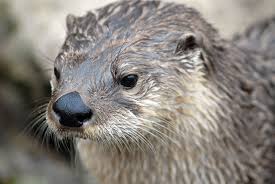Amazing Animals: River Otters

This is a River Otter. Note the small ears and nose pads.
May 14, 2018
Did you know that river otters are able to stay underwater for up to eight minutes? I sure didn’t! They’re also able to close their ears and nose so that the water doesn’t get into them. I mean, they would have to, because they can dive up to 60 feet underwater!
River otters have strong, slender, streamlined bodies. They can weigh up to 13 pounds, and can be as long as 3.7 ft. Their fur colors range from brown to grayish while their bellies are lighter and almost silverish. Their fur is thick and water repellent. Having water repellent fur means that the water doesn’t go past their fur. They will spend most of the day grooming their fur, rolling on the ground, rubbing on a tree, or using their paws and claws, to spread the water resistant oil all over their skin, so at night they can play (though they are not nocturnal or diurnal). Their eyes are on the tops of their heads for surface swimming, and they have acutely sensitive facial whiskers to locate their prey underwater. Their eyes have a third eyelid that they close under water so they’re still able to to swim and see. They use their powerful tail and webbed feet to swim far and fast. They’re well adapted to swimming against strong currents. Their four short legs have large, webbed paws with non-retractable claws. River Otter tails are about one-third the size of a river otters’ body. Their tail is flattened, heavily muscled, and extremely flexible. Otter tails are one of the main reasons that otters can swim so fast, up to 8 mph, and maneuver so well.
The River otter, North American otter, American otter, Canada otter, fish otter, land otter, or even the Prince of Wales otter are all different names for the river otter. The river otter lives all over Northern America, except for Florida Keys and American deserts. As their name suggests that they live in rivers, ponds, lakes, streams, wetlands, reservoirs, and even bogs. Though they are conscious about living in a clean environment, they will leave if the environment becomes polluted. River otters are carnivorous which means that they eat meat. River otters usually eat fish, but they will also eat what is most available such as crawdads/crayfish, mollusks, insects, birds, frogs, rodents, and turtles.
River otters can live up to 25 years in captivity. There is a drastic lifespan change from river otters in captivity to river otters living in the wild. In the wild they would only live 8-9 years. The oldest known river otter found in the wild was 13. Their mating season starts in December and lasts until April. Otters are not monogamous, the males will go from female to female trying to mate with as many as they can. Then the male will leave, and the female will raise the pups all by herself. Two to three pups will be born, and will be nursed for about 14 weeks. After one month, they will open their eyes, and at two months they will start to swim. They will stay with their mother for about a year, usually until the next litter is born. Then they will leave and start to look for new territory to call their home. In another year or two they will start looking for other otters to mate with, but they usually won’t be successful in mating until they are 5 to 6 years old.
The IUCN (International Union Conservation of Nature) classifies North American River Otter as Least Concerned. I respectfully disagree with the IUCN because the river otter’s habitat is being torn up, destroyed, burned, and paved over. I believe that very quickly their population will deteriorate, and yet again we will be too late in involving ourselves to save another animal species. Take action today and donate to WWF (World Wildlife Fund)!






